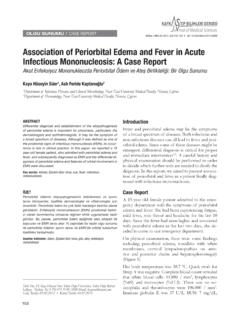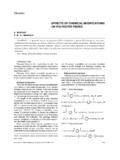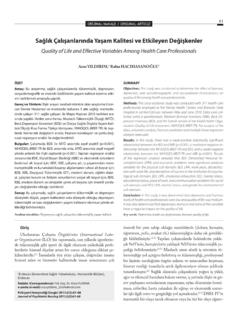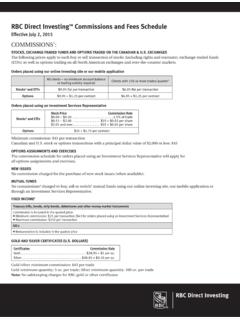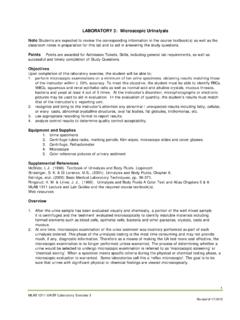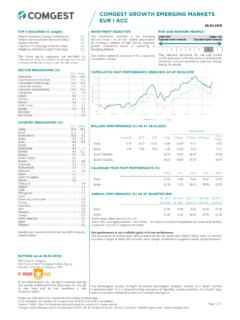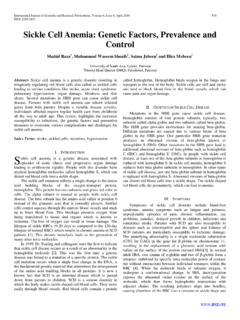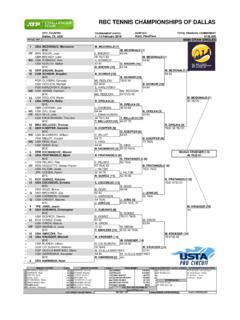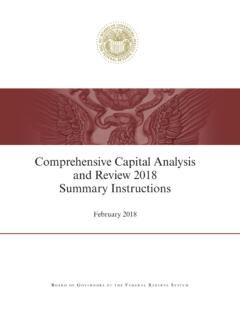Transcription of The estimation of platelet count from a blood smear on the ...
1 21 Research ArticleThe estimation of platelet count from a blood smear on the basis of the red cell: platelet ratioKan yaymas nda eritrosit ve trombosit oran incelenerek trombosit say s n n tayiniMohamed Brahimi1, Soufi Osmani1, Abdessamad Arabi1, Badra Enta-Soltan1, Zohra Taghezout2, Belkheir Smain Elkahili2, Mohamed Amine Bekadja11 Department of Hematology and Cell Therapy, University Hospital 1st November 1954, Oran, Algeria2 Pediatric Anti-Cancer Center, Emir Abdelkader, M ss rguine, Oran, AlgeriaAddress for Correspondence: Dr.
2 Mohamed Brahimi, 269 Hai Ekkakhla cannastel 31132 Oran, Algeria Phone: +213771485739 E-mail: The estimation of platelet count from blood smears is a daily routine laboratory test, which should be syste-matic each time the automated count is our laboratory, we estimate the platelet count indirectly by using the automated red blood cell (RBC) and calculating the platelet count on the basis of the red cell: platelet ratio in a stained blood film. In this study, we attempted to verify the reliability of this and Methods: One hundred ninety-one platelet counts were executed by two laboratory methods: an automa-ted count using an impedance cell counter and then a manual method by reviewing microscopic blood smears.
3 The number of platelets per 1000 erythrocytes was multiplied by the automated RBC (x106 cells/ l) to give an approxima-te manual count (x103 cells/ l). Two paired t-test was used for comparison of the two : The regression analyses for the entire data set collected in our study with the two laboratory methods gave the following least squares equation by comparing the automated (y) to the manual method (x): y= + (r= ). The paired t-test showed no significant difference between the two methods (p> ) and the Intra-class Correlation Coefficient (ICC) was equal to plot of the differences between the automated and manual values against their means according to Band and Altman design showed that the difference mean was with a standard deviation SD= noticed that 93% of the differences were within the agreement limits (mean 2SD)
4 , and that 77% of the differences were less than 20,000 platelets/ : Estimating platelet count on the basis of the red cell: platelet ratio is a reliable technique and it should be proposed as a method of reference. (Turk J Hematol 2009; 26: 21-4)Key words: estimation of platelet count , blood smear , red cell: platelet ratioReceived: June 10, 2008 Accepted: December 24, 2008 zetAma : Kan yaymalar ndan trombosit say s n n tahmin edilmesi g nl k rutin bir laboratuvar testi olup, otomatik say m hata-l oldu unda her seferinde sistematik olmal d r.
5 Biz laboratuvar m zda otomatik KK say m n kullanarak ve boyal kan rne- indeki k rm z kan h cresi:trombosit oran na dayal ekilde trombosit say s n hesap ederek, dolayl olarak trombosit say -s n tahmin ediyoruz. Bu al mada bu tekni in g venilirli ini do rulamaya al t estimation of platelet count from blood smears must be systematic each time the automated count is erroneous because even the most expensive and most effective machine is not able to replace human judgement [1-3]. Various proposals have been made for a reference method for platelet estimation [4-10].
6 Although platelet count is a daily routine laboratory test, the estimation techniques seem to have not been validated. This is due to the fact that the methods of validation of the diagnostic tests were finalized during the second half of the 20th century and researchersare tempted to validate the new methods first, especially the less widespread [11].The estimation technique used in our laboratory was pro-posed by Theml and other researchers [7-10] and is outlined herein with an attempt to verify its and MethodsBlood SamplesBlood samples were obtained from 191 patients, less than 15 years of age, who were receiving an anti-cancer chemo-therapy, as part of routine hematologic investigation or disease monitoring in our venous blood specimens were collected into tubes contain-ing ethylenediaminetetraacetic acid (K2 or K3 EDTA)
7 And then were stored at room temperature until analyzed within four was made if clots were seen in the blood sample or if the amount of blood in the tube was grossly inadequate such that a disproportionately high concentration of EDTA would be present; these samples were excluded from the MethodAfter thorough mixing of each blood sample on an auto-mated mixer for 10 min, a complete automated blood count was performed using an impedance cell counter (Coulter ACT), which was maintained and calibrated as recommended by the MethodThin air-dried blood smears made after thorough mixing of each sample were stained manually with a May-Gr nwald-Giemsa stain and examined under light microscopy with a X100 oil-immersion slides were entirely scanned for platelet aggregates and/or macrothrombocytes and, if any, the samples were excluded from the neither aggregates nor macrothrombocytes were found, the red cell.
8 platelet ratio was calculated in the monolayer zone of the smear as follows: The number of erythrocytes observed in a quarter of the oil-immersion field was multiplied by four instead of counting all the erythrocytes in the field, which is a laborious and time-consuming method. Then all the platelets in the same field were counted. Other fields were examined in the same way until we reached a minimum number of 1000 number of platelets per 1000 erythrocytes was multi-plied by the automated Red blood count (RBC) (x106cells/ l) to give an approximate manual count (x103cells/ l).
9 Statistical MethodSimple linear regression and difference plots were used to compare the manual platelet counts with the automated plate-let counts [12].The Shrout and Fleiss Intra-class Correlation Coefficient (ICC) was calculated in order to identify the degree of corre-spondence and the agreement between the two methods [13,14]. The ICC value is measured on a scale of 0 to 1, and in accordance with Portney and Watkins, good reliability was generally assumed as an ICC> [14].
10 A paired t-test was performed in order to assess the match between platelet count results by both methods [15]. In this evaluation, a statistically significant difference in platelet level was set at a level of p= report of evaluation on all 191 individual samples with the two laboratory methods gave the following least squares equa-tion by comparing the automated (y) to the manual method (x): y= + (r= ) (Figure 1).The paired t-test showed no significant difference between the two methods (p> ).



